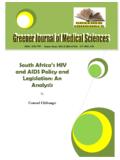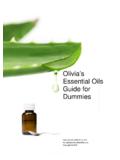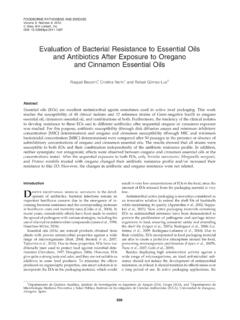Transcription of Analysis and Comparative Study of Essential Oil Extracted ...
1 Analysis and Comparative Study of Essential Oil Extracted from Nigerian Orange, Lemon and Lime Peels By Njoku Evbuomwan Greener Journal of Chemical Science and Technology Vol. 1 (1), pp. 006-014, May 2014. Research Article Analysis and Comparative Study of Essential Oil Extracted from Nigerian Orange, Lemon and Lime Peels * Njoku, Evbuomwan Department of Chemical Engineering, college of Graduate Studies, University of Port Harcourt, Choba, Nigeria. *Corresponding Author's Email: Phone: +2348037733196. ABSTRACT. Essential oils are a product obtained from vegetable raw materials and are complex mixtures whose composition may include volatile terpenic compounds. In this Study , the relationship between time and amount of Essential oil Extracted from the citrus peels using steam distillation was shown. Orange peel was shown to contain more amount of Essential oil (20ml at 180minutes) than lemon (7ml at 180minutes) and lime (5ml at 180minutes).
2 Using GC-MS. Analysis , 11, 12 and 24 chemical constituents were identified in orange, lemon and lime Essential oil respectively. The 3 main components and their percentage compositions are D-Limonene ( ), Pulegone ( ) and L- Carvone (2-cyclohexen-1-one) ( ) for orange peel Essential oil, D-limonene (64%), 2-cyclohexen-1-ol ( ). and -Pinene ( ) for lemon peel Essential oil, and -Pinene ( ), D-limonene ( ) and -Pinene ( ) for lime Essential oil. D-limonene was the most prevalent chemical constituent in orange and lemon Essential oil, but -Pinene was the most prevalent in lime peel Essential oil. Although lemon contained more D- limonene per unit volume of Essential oil, application of these percentages on the volume of Essential oil obtained from 370g of the peels at 180minutes showed that orange peel can deliver more D-limonene per unit mass of available peel.
3 Hence, orange peel Essential oil is a more economical source of D-limonene in Nigeria. Keywords: Quantitative, Analysis , Qualitative, Comparative , Extracted , Essential oil, Orange, Lemon, Lime. 1. INTRODUCTION. Essential oil from citrus is a large type of natural flavours and fragrances, which is popularly used in food industries, daily chemical product and health care field (Sheng-min et al., 2012). The citrus species are a potential source of variable oil which might be utilized for edible and other industrial application (Maria et al., 2012). Essential oils are broadly used as pharmaceutical components, in nutritious supplements and for cosmetic industry and aromatherapy (Maria et al., 2012). Guenther (1955) also stated that the oil is also employed in perfumes, toilet waters, eaux de cologne, and in cosmetics to which it impacts a refreshing top note.
4 Essential oils are a product obtained from vegetable raw materials (Berger, 2007), and are complex mixtures whose composition may include volatile terpenic compounds, which have the formula (C5H8)n, where the compounds are monoterpenes if n=2, sesquiterpenes when n=3, diterpenes when n=4 etc (Smith et al., 2001). These are secondary metabolites in plants (Mazen, 2002) and responsible for the characteristic aroma on the fruit. Lemon Essential oil are complex mixtures of chemical compounds like limonene, Y-terpinene, citral, linalool and -caryophyllene among others, which can be represented by three main classes, namely terpenes, oxygenates, and sesquiterpenes (Benvenuti et al., 2001). The most significant flavour compound is citral, while linalool possesses highly distinctive organoleptic characteristics.
5 In addition, limonene, myrcene, octanol, and Y- terpene among others contribute with high aroma flavour of lemon oil (Benvenuti et al., 2001). The composition of orange oil varies for several reasons. Region and seasonal changes as well as the method used for extraction lead to these variation. Gamarra et al. (2006) also stated that the quality of Essential oil depends on different factors; among them are the chemotype and biotype of the plant, the climatic conditions as well as the extractive process. Several compounds have been identified in orange oil with gas chromatograph- mass spectrometry. Most of the substances are part of the terpene group (limonene, -pinene, sabinene, - pinene, myrcene and -3-carene) with limonene being the dominant one. Long chain aliphatic hydrocarbon alcohols and aldehydes like octanol, decanal, and octanal are second important group of substances (Verzera et al.)
6 , 2004). Citrus fruits have a rough, robust and bright (green to yellow) coloured skin. They are usually 4 to 30cm long and 4 to 20cm in diameter, with a leathery surrounding rind or skin known as epicarp (or flavedo) that cover the fruits and protect it from damages. Citrus fruits are notable for their fragrance, partly due to flavanoids and limonoids contained in the rind (Manthey, 2004). The endocarp is rich in soluble sugar and contains significant 6. Greener Journal of Chemical Science and Technology Vol. 1 (1), pp. 006-014, May 2014. amounts of vitamin C, pectin, fibres, different organic acids and potassium salt which give the fruits its characteristic citrus flavour (Ezejiofor et al., 2011). Citrus juice also contains a high quality of organic acids (citric, malic, acetic and formic acids). In Nigeria and other parts of the world, citrus sinensis (sweet orange) are cheaply available, thus serves as a major source of vitamins in diets.
7 Orange fruit and its juice have several beneficial, nutritive and health properties (Okwu and Emenike, 2006). They are rich in vitamins especially ascorbic and folic acids. Over the last decades, many other virtues and medicinal benefits of orange fruits have been discovered besides their anti- scurvy property (Rapisararda, 1999). There is convincing epidemiological evidence that the consumption of orange fruit is beneficial to health and contributes to the prevention of degenerative process, particularly lowering incidence of degenerative process, particularly cardio and cerebro- vascular diseases (Rapisararda, 1999). The protection that orange fruit provides against these diseases has been attributed to the various antioxidant phytonutrients contained in citrus species (Okwu and Emenike, 2006; Rapisararda, 1999).
8 The current annual world production of citrus fruits is approximately 110 million tons, of which oranges constitute about 80 million tons (USDA, 2013). In Nigeria, about 930,000 tons of citrus fruits are produced annually from an estimate of 3 million hectares (FAO, 2008). The objective of the research was to: a. Determine the relationship between time and quantity of Essential oils obtained from citrus peels, b. Compare quantitatively the composition of Essential oils obtained from orange, lemon and lime peels, c. Determine the percentage of components present in the Essential oils , d. Identify the major components present in the composition, and e. Determine the physicochemical properties of the Essential oils . 2. MATERIALS AND METHODS. a. Steam Distillation Oranges used in this work were bought from Rumuokoro market in Portharcourt, Rivers state, Nigeria.
9 They were washed with de-ionized water, peeled and cut into small pieces. The orange peel was then weighed using RADWAG WAGI electronic top loading balance (AS 220/C/2) to obtain exactly 370grams. The orange peels were then pureed using MARLEX ELECTROLINE (Excella) blender. The pureed orange peel was then carefully transferred into a 1000ml flat bottom flask. 650ml of de- ionized water was measured using a 1000ml measuring cylinder and then added to the 1000ml flat bottom flask (distilling flask). Boiling chips was then added to the distilling flask to ensure that boiling occurs calmly without bumping. The experiment was then set-up as shown in Figure 1 below;. Figure 1: laboratory set-up for the steam distillation of citrus peel. Heating of the distilling flask was then slowly commenced using STUART HOT PLATE/ MAGNETIC STIRER.
10 The heat source was adjusted so that the distilling rate is approximately 20 drops per minutes. As the mixture boils and distils, de-ionized water was added via the separation funnel in the set-up just to keep the water level at Greener Journal of Chemical Science and Technology Vol. 1 (1), pp. 006-014, May 2014. the operation level preventing the water level from going too low which can cause the sugar in the puree to caramelize and burn and also keeping the heat at a low steady level. The experiment was conducted for the following times; 60, 100, 140 and 180 minutes, in each case, the distillate was collected and transferred into a 250ml separating funnel. 20ml of diethyl ether was added to the distillate in the separating funnel to extract the oil. It was ensured that there was no flame source or hot plate 'on'' during the use of diethyl ether because diethyl ether is very, very flammable.














